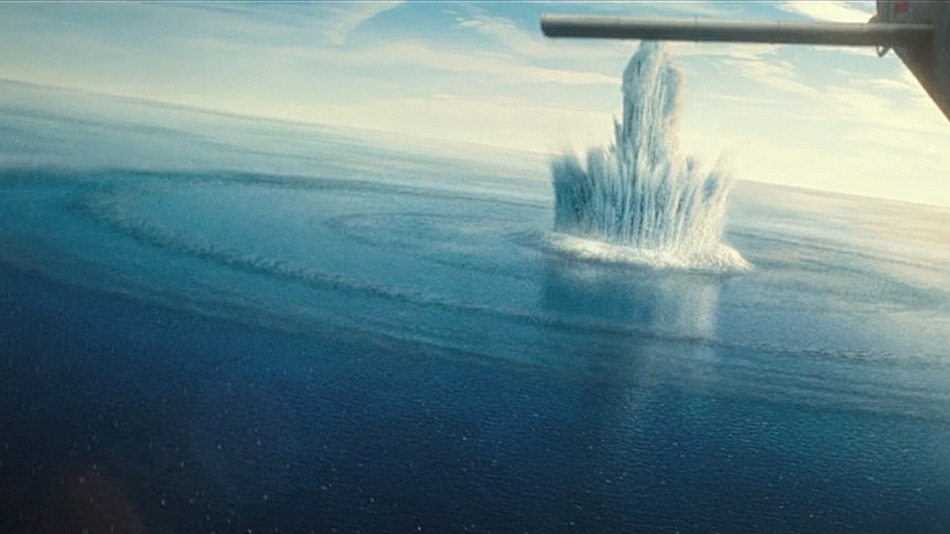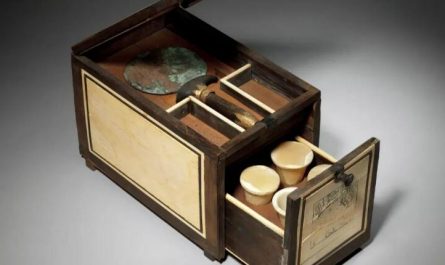Regarding the underwater nuclear explosion, there is an extra-long shot at the end of “American Assassin”, which simulates the killing effect of the underwater nuclear explosion in all directions, and it feels so shocking!
After the nuclear bomb exploded, a huge deep pit was recessed on the surface of the water, but the surrounding seawater was supplemented with the superimposition of shock waves, forming a mountain-like tsunami. The seawater like a wall directly drove the Ticonderoga cruiser of the U.S. Sixth Fleet and The Nimitz-class “Bush” aircraft carrier blows up and down!
If the largest nuclear bomb is detonated in the deepest part of the ocean, will it trigger a global tsunami?
The nuclear bomb in “American Assassin” estimated that the explosion depth is not great, because it takes about 30 seconds from the time the nuclear bomb is dropped to the explosion. The huge waves formed can make the aircraft carrier look like a flat boat in a storm, and what is left is still one. A nuclear bomb at the backpack level. If the largest nuclear bomb on the planet exploded at the bottom of the Mariana Trench, would the entire world be hit by a tsunami?
The Mariana Trench is about 11034 meters, about 11 kilometers deep under the sea. This is the deepest point in the world discovered by the British Royal Navy expedition ship “Challenger” in 1875. Humans have tried to explode the most powerful nuclear czar bomb, manufactured by the former Soviet Union. The hydrogen bomb with the largest power originally had an equivalent of 100 million tons, but it turned out that its explosive killing radius was too large to find a suitable test site. It was helpless to reduce the charge to 50 million tons!
The actual explosion power was 53 million tons. On October 30, 1961, it was tested in Xindi Island (air burst, 4200 meters high). All houses in the Sevoni Reclamation Land, 55 kilometers away from the core of the explosion, were destroyed, and hundreds of kilometers inside were destroyed. The structure is prevented from being flattened. The electromagnetic wave pulse after the explosion caused a one-hour radio window period in the northern hemisphere. Although this is an airburst, the magnitude of the Richter scale detected by the USGS (United States Geological Survey) is 5 to 5.25.
What would be the effect if it was detonated at the bottom of the Mariana Trench?
The effect of underwater explosion is very different from that of ground and air explosion, because the density of air and water is 772 times different, so the effect of underwater explosion is very interesting:
After a nuclear bomb explodes in deep water, its high temperature and ultra-high energy diffusion will form a large bubble. This bubble will expand rapidly, but at the end it will be compressed by water, forming a repeated oscillation and will continue to be under the buoyancy of water. Bubbles rising to the surface!
This expanded bubble is very powerful. Even a torpedo with ordinary explosive charges can break the attacked warship into two in one shot. It is only because the impact of the expansion and contraction of this huge bubble will lift the middle of the hull and fall down. At the time it will sink, and the hull, the wavelength and the hull are roughly the same, this effect will directly break the hull, so the detonation depth of the torpedo attack is below the keel, it does not hit the hull before it explodes!
Deep water or shallow water detonation, which one is more powerful?
Therefore, the depth of the detonation water has a great relationship with the power. If the detonation height is very shallow, a water column will be formed directly during the explosion, just like a water column formed by a bomb thrown in the water. If it is deeper, the compressed water bubbles after diffusion will cause the water surface to sink. , Such as the depression effect formed in “American Assassin”, but at this time the surrounding sea water will be replenished, and it will form a superimposed effect with the water bubble that spreads again, forming a super tsunami!
If the initiation depth is very deep, then the water bubble will dissipate energy in repeated oscillations, and finally become a large bubble that rises to the surface, just like a large bubble popping from the bottom of the water, because the energy of the nuclear explosion is dispersed into the ocean, despite these The energy will not disappear, but when it reaches the surface, it can no longer pose a threat.
How to assess the threat?
It mainly depends on the diameter of the bubble. If it is closer to the surface of the water, then a tsunami may be formed. Then, a tsar bomb explodes at a depth of 11 kilometers. What will happen? The diameter of bubbles formed by underwater nuclear explosion energy is as follows (refer to the calculation of the “equipment space” of the next big brother):
The denominator part is the seawater atmospheric pressure + 1 atmospheric pressure. You need to pay attention to it, but even if you don’t increase the pressure, the difference is not big. The radius of the cavity formed is only 580 meters, which is 1160 meters in diameter, even though a 1.1 km can be formed at the bottom of the ocean at 11 kilometers. The kilometer space is too scary, but for the 10 kilometers thick tens of billion tons of seawater (1160 meters in diameter, 10 kilometers of cylindrical seawater about 10.5 billion tons), it will not pose too much threat!
So this big bubble will dissipate energy in the oscillating rise, and when it comes out of the water, it’s just a fart from the sea! It can also cause some impact, but it is still too far away from the tsunami! However, playing with a nuclear explosion on a subduction zone such as the Mariana Trench has an earthquake risk several orders of magnitude higher than a tsunami, so we are more worried about causing some induced earthquakes!
Is the nuclear explosion scene of “American Assassin” reliable?
There are several anti-common sense effects in the plot. Whether it is true or not, it is necessary to understand:
1. The surface of the water will sink first, and then a huge wave will rise to the sky
2. The shock wave can blow off the mast of the Ticonderoga cruiser
3. Under the shock wave of a nuclear explosion, a helicopter close to the core of the explosion can survive
4. Nuclear explosion energy caused a monstrous tsunami, and nearby ships will be hit by the tsunami.
5. The Nimitz-class “Bush” aircraft carrier of the Sixth Fleet will be hit by huge waves like a flat boat
In this long shot showing the nuclear explosion effect in all directions, if judged according to scientific standards, probably only the first effect is accurate, and the other effects are all based on the visual effects with considerable special effects processing. Of course, this can be done. Understand, after all, the visual effects of commercial blockbusters are the first!
The nuclear bomb thrown from the boat into the sea, the time set in the play is 30 seconds, but the author counted it almost more than 2 minutes, of course, this is not a count, after all, the plot can shoot 1 second into 1 minute, press 1 per second The sinking speed of meters is about 30M, which indeed meets the requirements of shallow water initiation.
Similar to this is the “Operation Crossroads” carried out by the United States in Bikini Atoll in 1946. An atomic bomb of 21,000 tons equivalent was detonated 27 meters below Bikini Atoll, and LSM from the nearest 0 meters was arranged around it. Dozens of surface ships, including the landing ship -60 and the heavy cruiser Prinz Eugen, 1600 meters away, were used to observe the damage effect.
After detonation, a 150-diameter bubble threw 2 million tons of sea water and coral reefs into the air, forming a water wall of 1,800 meters high, 610 wide, and 91 meters thick. After falling back to the surface, a tsunami was formed, spreading around:
After the nuclear explosion, the LSM-60 landing ship did not leave any recognizable wreckage. Eight other warships sank after the nuclear explosion, including the Arkansas battleship 160 meters away, the Saratoga aircraft carrier 410 meters away, and 700 meters away. The Nagato battleship and so on. However, Prinz Eugen survived the nuclear explosion 1800 meters away, and has since conducted another nuclear test.
4 milliseconds after initiation
5 seconds after initiation
Distance and angle are very important. The best way to accept the impact of the tsunami is to greet the tsunami by the bow. Horizontal ships will receive the greatest impact and are easy to capsize, but the vertical arrangement can obviously improve this situation. The heavy cruiser Prince Eugen has a difference Angle, and the distance is relatively far, this is the key to escape.
According to the ratio in the figure, the distance between the core of the nuclear explosion and the Sixth Fleet is less than 2 kilometers. The backpack-type nuclear bomb has an equivalent of only a few thousand tons, and its damage effect is much worse than that of the “Operation Crossroads” nuclear bomb. From the perspective of distance and the damage effect of the nuclear explosion, although “American Assassin” is a bit exaggerated, it is still reasonable and barely qualified!
But the helicopter is unlikely to survive this level of nuclear explosion, because the large propeller is very easy to break and crash after being impacted!






